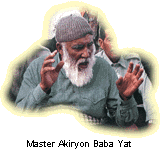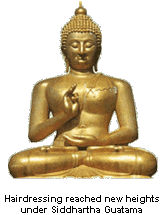|
The Story of Siddhartha
The  greatest blessing of my many lives, a pantheon spanning more than two millennia, aside from the vast
accumulation of knowledge, and a generous sampling of the world's finest cuisine (as well as all its inebriative feminine pleasures), has been the opportunity to have known
some of the most august and bounteous souls the gods have ever set upon this lonely orb. This has also provided me hours of gentle amusement as I have listened to the
learned of each consecutive age describe those I knew only too well in terms neither accurate nor complete. Many of these now transmutated friends would also find this a
beguiling pastime and would share my mirth at the counterfactual retelling of their lives and deeds. Countless hours I spent with my dolphin friends attempting to rid them of
mind-numbing fallacies of this very sort, but most often to no avail, so deeply ingrained were their beliefs. Nor has it been so different with my human disciples, many of whom have taken to heart a myth, and in doing so, have
come to grief when they have discovered that what they treasured as soft and pliant gold was no more than brightly painted, fresh dung. greatest blessing of my many lives, a pantheon spanning more than two millennia, aside from the vast
accumulation of knowledge, and a generous sampling of the world's finest cuisine (as well as all its inebriative feminine pleasures), has been the opportunity to have known
some of the most august and bounteous souls the gods have ever set upon this lonely orb. This has also provided me hours of gentle amusement as I have listened to the
learned of each consecutive age describe those I knew only too well in terms neither accurate nor complete. Many of these now transmutated friends would also find this a
beguiling pastime and would share my mirth at the counterfactual retelling of their lives and deeds. Countless hours I spent with my dolphin friends attempting to rid them of
mind-numbing fallacies of this very sort, but most often to no avail, so deeply ingrained were their beliefs. Nor has it been so different with my human disciples, many of whom have taken to heart a myth, and in doing so, have
come to grief when they have discovered that what they treasured as soft and pliant gold was no more than brightly painted, fresh dung.
This was never more evident than when one of my young pupils asked me to tell him about the Buddha, whom he revered in ways both dramatic and irritating. Since I had known Guatama throughout his short eighty year life,
I drew a deep breath, girded my loins and related this short, but precise biography:
Siddhartha Guatama, or Sid, as we used to call him, was born around 567 B.C., in a small kingdom near Nepal. His father was a chief of the Shakya clan. It is said that twelve years before his birth the Brahmins
prophesied that he would become either a universal monarch, a great sage or a dancer. This shows how incredibly wrong Brahmins can be. To prevent him from becoming an ascetic, or from just wandering off, as he
was wont to do, his father kept him locked in the palace. Sid grew up in princely luxury, shielded from the outside world, entertained by dancing girls (in which he had only passing interest, being most consumed with trying on
their sheer and silky finery). He also spent much time practicing archery, swordsmanship, wrestling, swimming, and running. These things he did all by himself to everyone's general consternation and befuddlement. He took
many, many showers. He also spent hours uncounted studying flower arrangement and interior design.
And yet, it was not enough. He was drawn to the lurid streets beyond his castle walls. There, in the olid and
gray streets of Kapilavastu, he encountered three things: a sick man, an old, sick man, and a man so sick he was dead. Nothing in his life of ease and many hot showers had prepared him for this experience, and when his
charioteer informed him that all beings are subject to sickness, old age, and death, he was beyond himself. For you see, whenever someone had died in the castle, they had told Sid that person had "gone shopping", and being
somewhat less than well-endowed in the intellectual sense, he readily believed it. Returning to the palace, he passed a wandering ascetic walking peacefully along the road, wearing the robe and carrying the single bowl of a sadhu, and he resolved to leave the palace in search of the answer to this bewildering problem of suffering. Plus,
he really liked the robe and the bowl would be excellent for a new flower arrangement he was working on. So after stopping in a robe shop, he cut his hair and headed for the forest. Unfortunately, being unfamiliar with life
outside his palace, he could not find it. Several weeks later he was guided there successfully by a blind and crippled beggar.
Immediately Sid made friends with other outcasts who had headed for the forest. They began to teach him their
ways and he in turn assisted them in decorating their lair, in sort of a neoclassical, yet functional style. His teacher,
Arada Kalama, instructed him daily and was amazed how quickly Sid was able to discipline his mind to enter the sphere of nothingness. Of course Sid had been doing this since he was born, it being what his mind was
perpetually full of at all times.
For six years Sid along with five very manly and gregarious companions practiced "austerities" (as they called
this particular behavior), concentration and hairdressing. He drove himself mercilessly, eating only a single grain of
rice a day, pitting mind against body, which was not, in a word, a fair fight. His ribs stuck through his wasted flesh
and he seemed more dead than alive. It was then that Sid realized, among other things, that he was rather hungry. Entering a village in search of food, he met a "woman" named Sujata who offered him a dish of milk, a jar of
honey and an unforgettable evening. Six days later, he washed himself in the Nairanjana River, and then set off to the Bodhi tree. No one knows why. There he spread a mat of kusha grass beneath its boughs, crossed his legs
and sat. And sat. And sat.
Six days later he opened his eyes and saw the morning star. It was a revelation. He had thought he had gone
blind, but on opening his eyes, he realized he could see and that his blindness had been a result of his eyes being
firmly closed . "Wonder of wonders," he is reported to have said, "this very enlightenment is the nature of all
beings, and yet they are unhappy for lack of it." So it was that Sid woke up (to a degree) at the age of thirty-five,
and became the Buddha, the Awakened One, known as Shakyamuni, the sage of the Shakyas. Yet after six days sitting under the bodhi tree, his legs had fallen asleep and he could not arise to tell anyone about it for several hours.
It was at this time that he became a teacher and established a following, his sangha, of monks or bhikshus These bhikshus lived simply, owning only a bowl, a robe, a needle, a water strainer, a studded leather posing
codpiece, and a razor, since they shaved their heads as a sign of having left home (and to reduce lice infestations). They traveled around northeastern India, practicing meditation, bondage and discipline, and begging for their
meals. This last art they learned by watching Sid, who would go from house to house and stand silently at each door, bowl in hand, waiting for someone to open it. In reality, he was not begging but simply couldn't remember
where he lived. As he had also never mastered the concept of door-knocking, it was never passed on to his disciples. They maintain this annoying custom to this day.
His teaching, however, was not only for the monastic community. He had instructed them to bring it to all: "Go ye, O bhikshus, for the gain of the many, the welfare of the many, in compassion for the world, for the good, for
the gain, for the welfare of gods and men and a proper color and fabric scheme in every home."
For the next forty-nine years Sid walked through the villages and towns of India, still unable to remember the
location of his home, speaking in the local dialects with common figures of speech that everyone could understand, including himself. He taught a villager to practice "mindfulness" while drawing water from a well, and
after Sid had been removed from the well and dried off, they brought him a very distraught mother. She pleaded with him to heal the dead child she carried in her bony arms, yet he did not perform a miracle, but in stead
instructed her to bring him a mustard seed from a house where no one had ever died. She returned from her search without the seed, but with the knowledge that death is
universal. So Sid never did get that mustard seed he so fervently desired. stead
instructed her to bring him a mustard seed from a house where no one had ever died. She returned from her search without the seed, but with the knowledge that death is
universal. So Sid never did get that mustard seed he so fervently desired.
This life of wandering, begging, meditation and hairdressing continued for many
years, until Sid died in the town of Kushinagara, at the age of eighty, having eaten a meal of pork or mushrooms. It was a particular problem he had always had,
differentiating between pork and mushrooms. Sheep and raisins were especially confusing to him as well. Some of the assembled monks were despondent, but the
Sid, lying on his side, with his head resting on his right hand, reminded them that everything is temporary, and advised them to take refuge in themselves, nude posing,
and the dharma—the teaching. He asked for final questions. None raised their hands. Then he spoke his last words: "Now then, mighty bhikshus, I address you: all
compound things are subject to decay; strive diligently." With that he died. Immediately several hands were raised, but it was too late.
Yet the legacy of Siddhartha Guatama remained. The poor village in which he died was teeming with his many and dedicated disciples. As it was in a time of severe drought and famine, this was a ominous concern as the
villagers, with barely enough to keep themselves alive, must needs feed the bhikshus, who were always hungry after their pose downs and ritual spankings. And it was then that this became the proverb of Kushinagara, "When
the Buddha died, he left some mighty bhikshus for us to fill." So it remains today.
 |
|
|
Dolphins, reincarnation, New Age, philosophy, humor, poetry, teaching, ascended masters, fish, Baba, crystals, spirituality, karma,
India, idiots, Akiryon Baba Yat, The Dolphin Sky Foundation, zen, transcendental meditation, past lives, fish, satire, religion, religious satire, sufism, cetaceans, Hinduism, Sikhism, Buddhism, Eastern religions
|
|